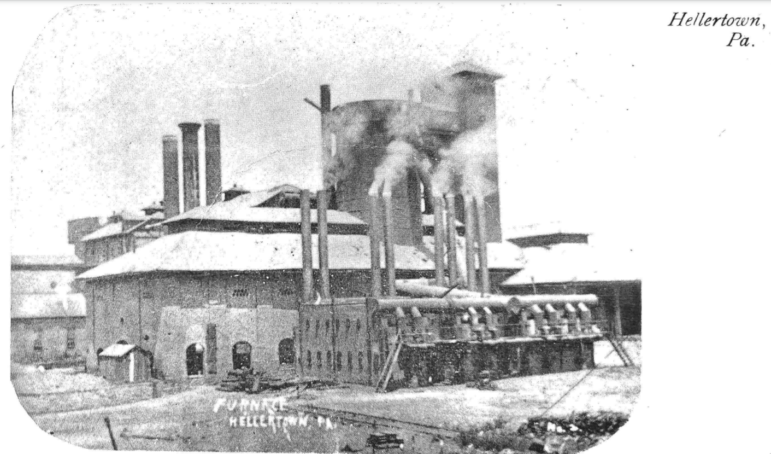“When in the course of human events” in Hellertown it becomes necessary to commemorate the end of an era that few remember, we give pause to contemplate the 100th anniversary of the piece of the fabled Thomas Iron Works which ended in 1920.
One year after the end of the Civil War, in 1866, the Saucon Iron and Railroad Company was established right here in what then was Lower Saucon Township, later the borough of Hellertown. It would remain until its sale in 1884 to Thomas Iron, producer of necessary pig iron until being replaced by the steel industry locally centered in Bethlehem.

The Thomas Iron Works was located along the Saucon Creek in Hellertown. When its furnaces fell silent in 1920, the borough’s heavy industrial era ended.
The inordinate supply of brown hematite iron ore and limestone in Lower Saucon supplied the Saucon and Thomas Iron companies with needed resources between 1866 and 1920. Thus, we need to celebrate local contributions as vital to America’s Industrial Revolution.
I thank God that many locals banded together to save the land from development just a few years ago. We can enjoy the Saucon Creek, Saucon Rail Trail and the woodland known as the Cinderbanks area. If the Reading Railroad had not destroyed the remnants of the factory, we would have a monument of the treasured past of Hellertown. Now being declared a park, this wild habitat will not vanish as have many open spaces in the Lehigh Valley.
Recently, I was fortunate to purchase online a 1904 book celebrating the 50th anniversary of the Thomas Iron Company that was only given to investors as a gift. This treasured book, titled “The Thomas Iron Company 1854-1904,” was published for “distribution to Stockholders in Commemoration of the Fiftieth Anniversary of the Organization of the Company” that by then included four furnaces: Hokendauqua, Lock Ridge, Keystone and Saucon. Early meetings of the company were held at Mrs. White’s Tavern at Centre Square in Easton, the first of which occurred on Feb. 14, 1854. The company was named after David Thomas, who was the first person in history to be successful in manufacturing iron using hard coal or anthracite. He had been urged to emigrate to the U.S. to establish the company. Born in 1794 in Tyllwyd, South Wales, Thomas died in 1882, just two years before the company purchased the Saucon plant.
Several years ago I purchased an original “No Trespassing” sign with the “Saucon Iron and Railroad Company” name on it at a local antique emporium in Allentown. However, I had never heard anyone call it exactly by its official name at Hellertown Historical Society, where I volunteered after retirement. Some folks questioned whether the sign was from the local plant. This book confirms that it is from near my Hellertown home, just west of Thomas Avenue. Two years ago I dug up a three-foot section of narrow gauge rail with some cement attached where it had been fastened atop one of those huge cement pillars along the old rail trail. The trains carried various ores to the Saucon Plant from the north and deposited the ore between the pillars. The train had traveled on top of these pillars. The ore was then used in the blast furnace nearby.
If one wonders why there are cement structures in the Saucon Creek, you can be assured that they supported other rail cars either carrying ore or limestone from Lower Saucon quarries. Over the last 15 years, I have walked and explored nearly every trail throughout the Hellertown acreage surrounding and crossing the old iron company and have cleaned up much trash everywhere it lay, while finding some historic artifacts which I have collected. Most residents would call the items “junk,” but not so. They remind one of very old days when some of my friends’ grandparents were employed by Thomas Iron. To be sure, Hellertown owns the entire area near Water Street Park and along the Saucon up to the Bethlehem border.
My “new” old book provides photos and historic details that I had never viewed or learned. For example, the Thomas Iron Company had erected the North Penn branch of the Philadelphia and Reading Railway and two furnaces known as No. 10 and No. 11, engineered by John Hartman, the first person in America to “make the designing of blast furnaces a specialty,” at the time under the employ of Saucon Iron. There were 15 workmen’s cottages built along Thomas Avenue and nearby narrow streets. They are yet inhabited by Hellertown families with additions built onto them. I feel that the area west of the new Saucon Rail Trail should at least bear one historic marker to honor the area now consisting of woodland and the Cinderbanks north of Water Street Park. Perhaps Hellertown Borough and interested politicians, with the support of citizens, could erect at least one official historical marker to inform passersby of the importance of this section of the borough. Remember that Thomas Iron played an important part in World War I.
Lee Weidner is a retired teacher, local historian and author from Hellertown. Among his published works are Saucon Secrets (volumes I and II) and Images of America: Hellertown, which he co-authored with the Hellertown Historical Society.







